When you own a home or reside near a body of water, you’re bound to come across various species of snakes. You’ll probably stumble across a snake or two, even though most of them are harmless critters looking for water. As their name suggests, water snakes are non-venomous snakes that prefer spending time in the water. These snakes are not venomous or dangerous, contrary to popular belief. However, they are known to be aggressive. Even if you don’t touch them, they may get aggressive if you approach them.
Water snakes aren’t constrictors either. They eat their prey while it is still alive. They open their lips wide, wait for it to pass, and then close them around it. Despite that, these slithering fellas do not think of you as food and will not attempt to feed on you. But what do water snakes eat? Do they eat fish? Or do they feed on land animals? Below, let’s explore what food water snakes like to eat, what each species consumes, and how they hunt in the wild.
What Do Water Snakes Eat?
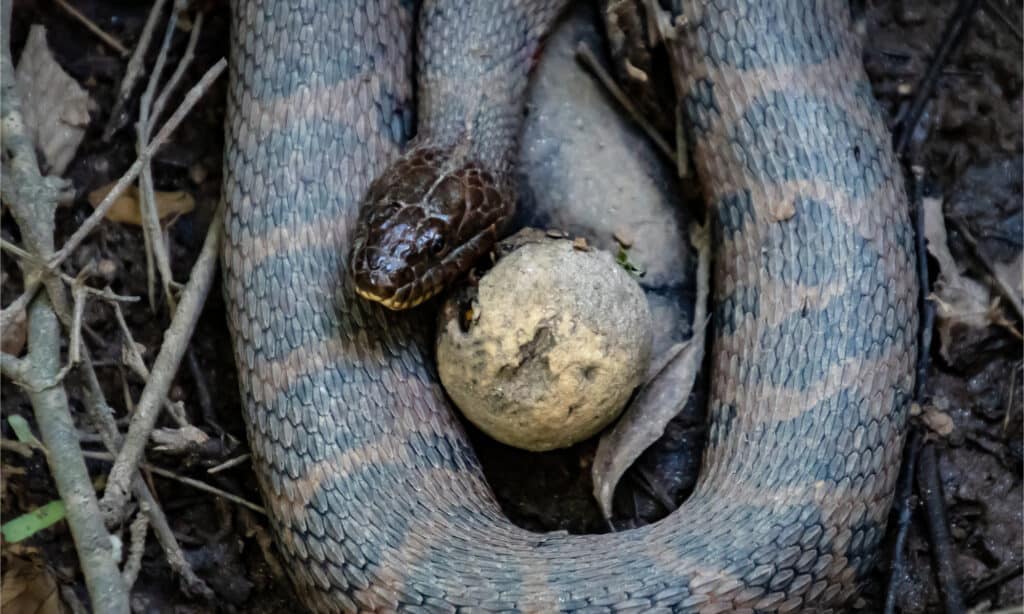
Water snakes are carnivores that eat mainly aquatic and semi-aquatic organisms such as fish, toads, and frogs.
©Deborah Ferrin/Shutterstock.com
Generally, water snakes are carnivorous snakes that eat mainly aquatic and semi-aquatic organisms such as fish, toads, frogs, crayfish, salamander, insects, baby reptiles, and other invertebrates. Water snakes also feed on land animals such as rodents, mice, shrews, and other small mammals.
Water snakes seek amphibians and fish in and near the water. They transition from fish to larger creatures like salamanders and toads when they reach a length of 1.5 feet (45 cm). Fish is the principal source of nourishment for smaller water snakes.
Northern water snakes only associate in the fall and spring after overwintering. They congregate in clusters around basking places and prefer to be alone, especially during the warmer months. Overhanging branches, paths, beaver lodges, dried cattail stems, and other shallow locations in the river are all popular spots for water snakes to bask. Water snakes can be seen at any time of day or night. They are, however, more active during the day.
How Do Water Snakes Eat?
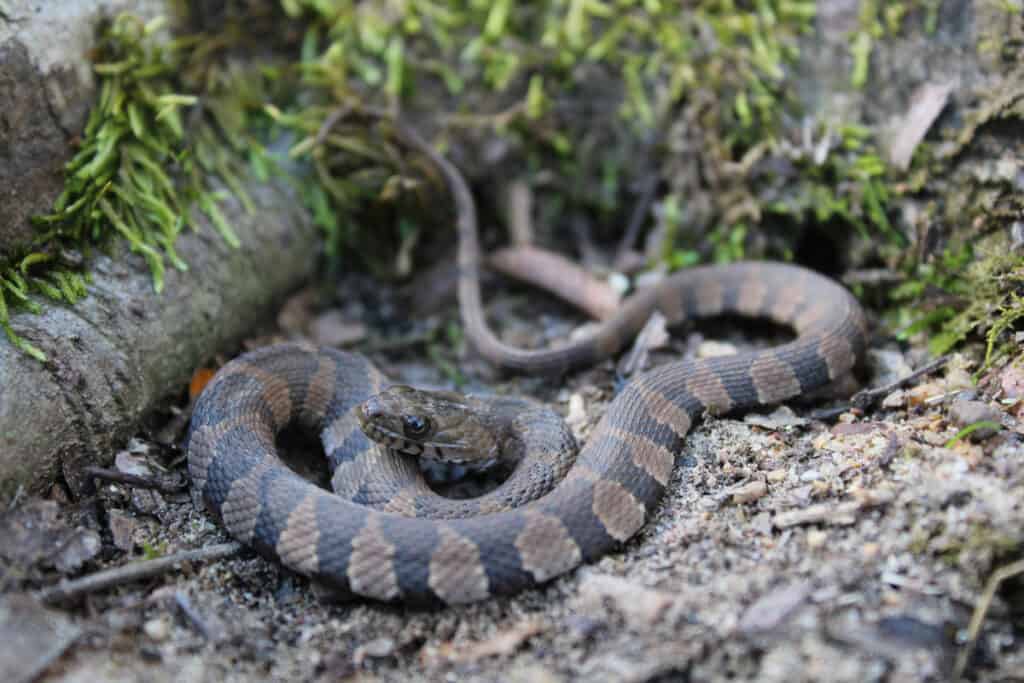
The midland water snake can be found in a small section of the Florida panhandle.
©Tucker Heptinstall/Shutterstock.com
Water snakes prefer to eat near or in water. Since they do not possess venomous fangs and are not constrictors, they swallow and eat their prey while it is still alive. They wait for prey to pass by in shallow waters with their mouths wide, then snap their jaws around it. They also look for prey on the lake or river bottom; searching behind rocks, branches, and cracks. Although water snakes do not have venom, their saliva contains venom-like proteins (anticoagulants) that induce blood loss. An anticoagulant is a protein that causes wounds to flow more abundantly. If the prey flees, the water snake can track its blood trail.
What Kind of Teeth Do Water Snakes Have?
As water snakes are non-venomous snakes, they do not possess sharp fangs in their upper mandible that inject venom into their prey. Like most non-venomous snakes, water snakes have rows of long, thin, conical, and sharp yet tiny teeth arranged backward, with one row lining the lower jaw and two lining the upper.
Because they have anticoagulants in their saliva, their rows of tiny teeth do more than just scratch the skin. Anticoagulants prevent blood from clotting, resulting in greater bleeding than a snake bite would cause. These proteins may pose a risk to their small-bodied victims since they can aid the water snake in tracking down its victim’s blood flow if it flees. The good news is that their anticoagulants are safe for humans and larger animals.
What Do Different Types of Water Snakes Eat?
The term “water snake” is a general term used to describe aquatic or semi-aquatic snakes inhabiting bodies of water. But there isn’t only one type of water snake. Water snakes come in various shapes and sizes and can be found all around the United States. They are all members of the Nerodia genus, and their semi-aquatic lifestyle is their greatest distinguishing feature. Some live throughout the eastern United States, while others are restricted to a few rivers. So, what does each type of water snake eat?
Diamondback Water Snake
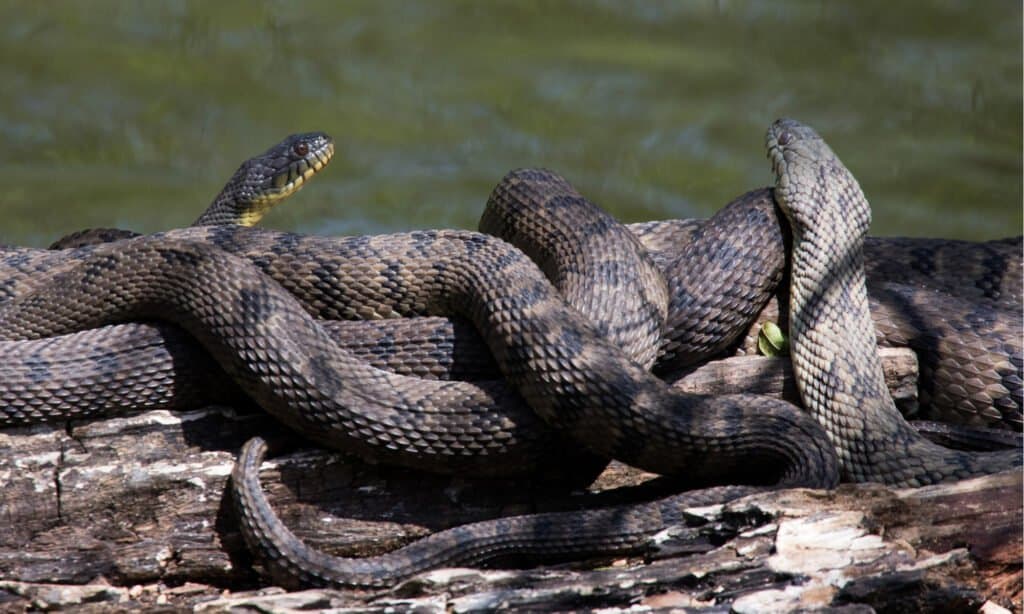
Diamondback water snakes eat a diet that includes amphibians, insects, and baby turtles.
©Laurie L. Snidow/Shutterstock.com
Catfish, amphibians, baby turtles, insects, smaller snakes, crayfish, and small mammals are the main prey of diamondback water snakes. They are non-venomous and non-aggressive and are frequently confused with the cottonmouth. They spray musk from their anal glands to ward off predators when they are threatened.
Diamondback snakes can be found near permanent water sources such as lakes, ponds, and rivers in the eastern United States. These large snakes can grow up to five feet long and give birth to up to 50 babies at a time. They have noticeable darker hexagonal bands encircling their bodies’ length, ranging from yellow to brown in hue.
Northern Water Snake
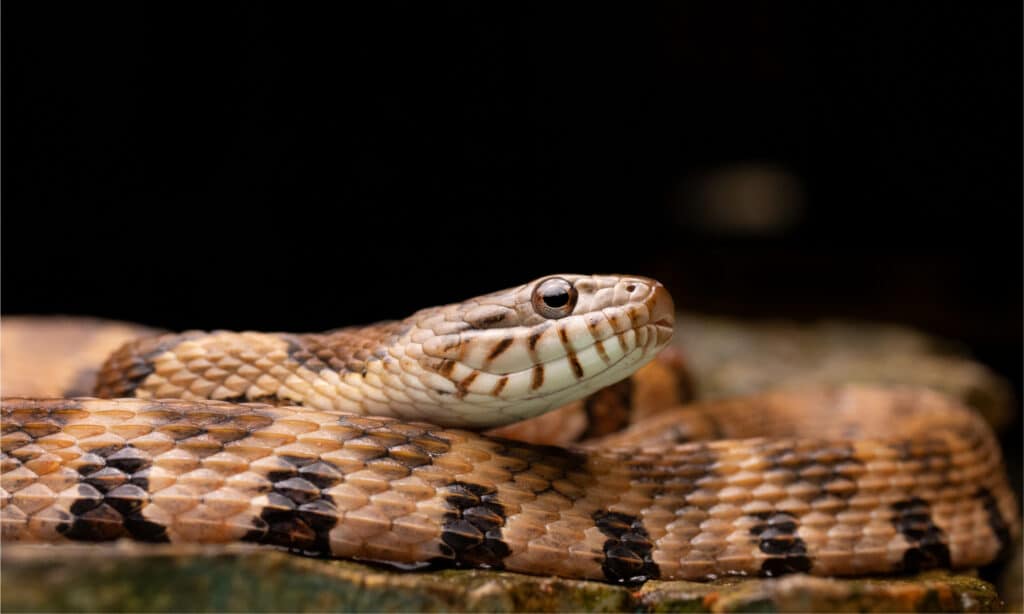
Northern water snakes are yellow to gray with darker splotches.
©Radiant Reptilia/Shutterstock.com
Amphibians, fish, smaller or young reptiles, rodents, and small mammals are all prey for northern water snakes. These snakes are semi-aquatic and frequently emerge from the water to sunbathe. They like to rest on rocks near the water or hang out on branches that overhang the water, similar to many other species of water snake. Their bodies are yellow to gray with darker splotches and grow to reach between 2 and 4.5 feet long.
They are not venomous; however, northern water snakes are ambush predators. They hunt small fish sleeping in shallow water during the day and near the water’s edge in plants at night. Northern water snakes settle all across eastern and central North America, with populations in Southeast Canada and the Northeastern United States particularly abundant.
Banded Water Snake
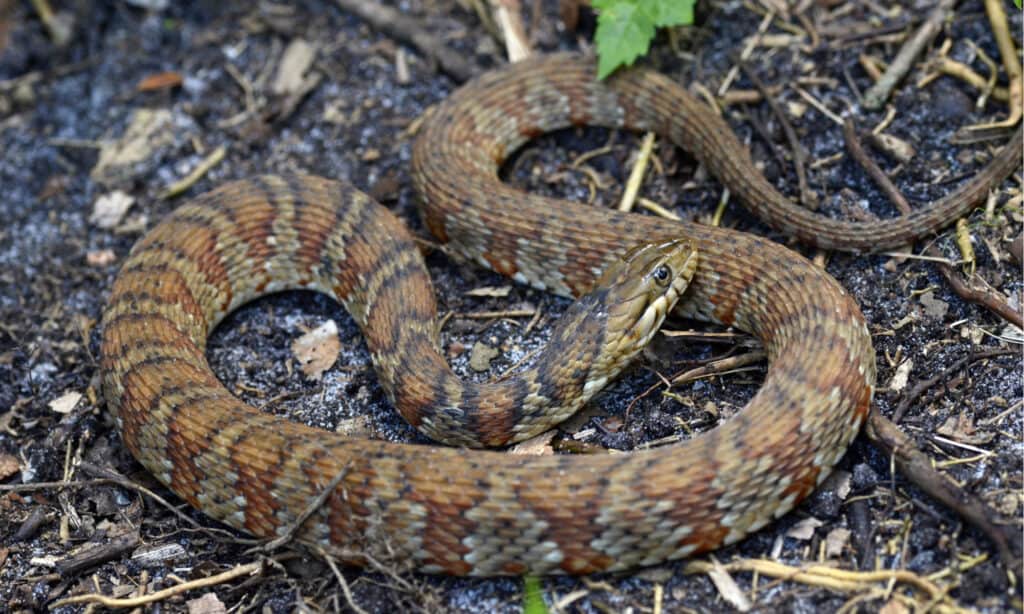
Banded water snakes eat crayfish, newts, and tadpoles.
©Patrick K. Campbell/Shutterstock.com
Along with the northern water snake, the banded water snake is among the most common water snakes in the US. Frogs, salamanders, newts, crayfish, fish, toads, and tadpoles are the most common prey of banded water snakes. They’re not aggressive, but if threatened or provoked, they’ll bite. Banded water snakes can be found in Alabama throughout the Coastal Plain, Georgia, Florida, South Carolina, and North Carolina. They like flowing water sources such as cypress creeks, rivers, and canals, although they can also be found in lakes and marshlands.
These snakes significantly impact the environment by regulating the populations of their principal prey, such as fish and amphibians. Likewise, large birds of prey, such as the great blue heron, larger snakes, and other semi-aquatic animals, such as alligators, prey on the banded water snake.
Banded water snakes are medium-sized non-venomous reptiles with hefty bodies. This species is smaller than other water snake species, reaching a maximum length of 3-3.5 feet, yet it has a large body for its size.
Brown Water Snake
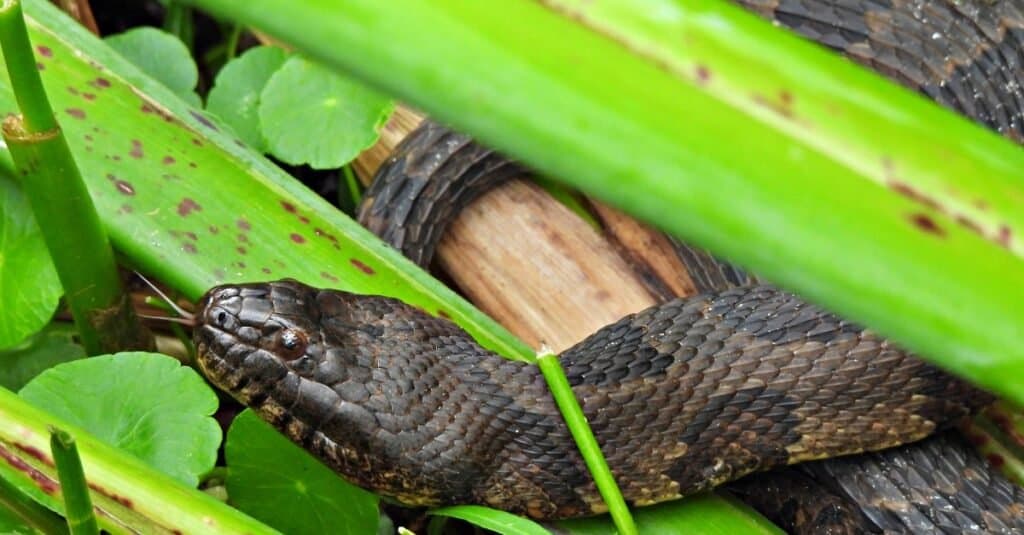
Fish is the brown water snake primary food.
©iStock.com/passion4nature
The brown water snake is another common type of water snake from North America. Although these snakes feed primarily on fish, they take on far more dangerous prey, such as the catfish with sharp spines! After the catfish is swallowed, its spines may penetrate the snake’s skin, but the snake normally survives and recovers. The spines of catfish devoured by brown snakes usually poke out of their sides. Although these snakes are non-venomous and non-aggressive, they can be confused with the dangerous cottonmouth.
Brown water snakes are only found in southeastern North America and are indigenous to the region. Florida, Georgia, Alabama, Louisiana, North Carolina, South Carolina, Mississippi, Missouri, and Virginia are included. Brown water snakes can be found anywhere from sea level to 500 feet. Streams, swamps, and other moist places make up their habitat and location. They require an aquatic habitat because fish is their primary food source.
Throughout its range, the brown water snake is common or of minor significance. Although the brown water snake is not protected in much of its territory, it is unlawful to kill it in several areas, including Georgia.
Green Water Snake
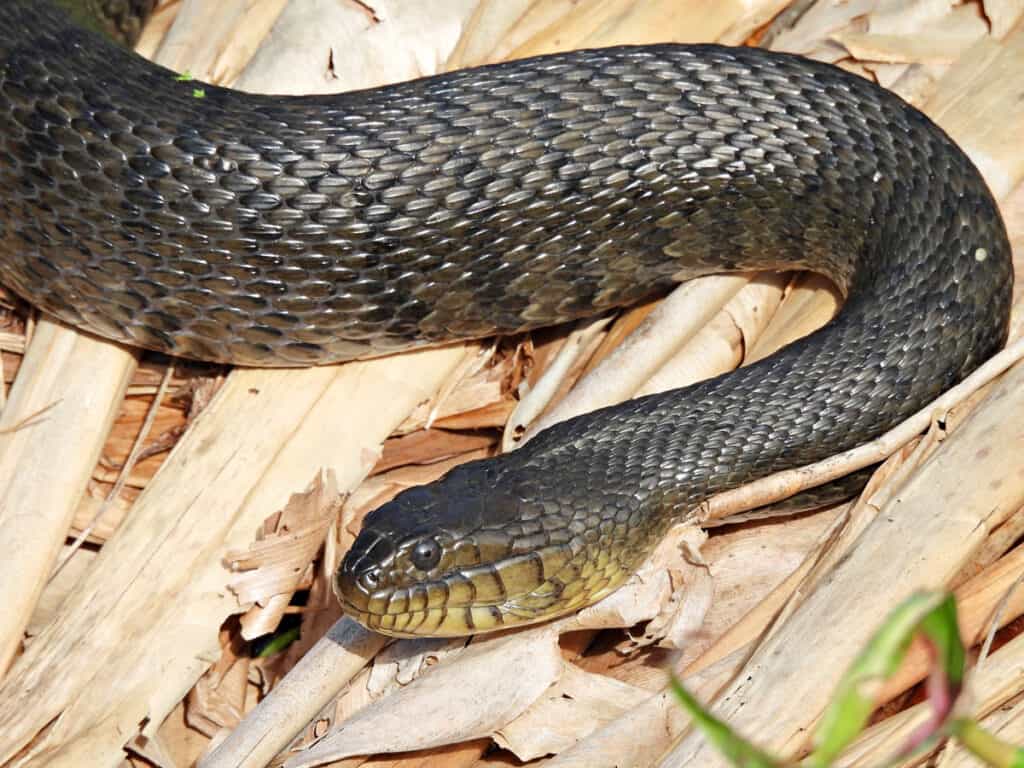
The Florida green watersnake can be found all over Florida and has a distinctly large head.
©iStock.com/passion4nature
The green water snake is a frequent, gentle snake found in scraggly marshes and grasses near ponds and canals, occasionally sunbathing in the foliage. They eat tadpoles, frogs, newts, salamanders, and fish, as do most water snakes. These snakes are more active throughout the day, although they can be spotted preying on minnows or tiny fish in the early evenings. Green water snakes in Florida are good swimmers and can dive into the water from logs or tree limbs. They can also have litters of up to 100 babies and bear them alive!
Plain-Bellied Water Snake

Plain-bellied water snakes are piscivores, which means they feed mainly on fish and amphibians such as crayfish, frogs, and salamanders.
They are most active throughout the day, basking or resting in the foliage near water or hanging from branches above it. This also aids them in escaping danger by allowing them to submerge themselves in water quickly. These snakes venture onto land, particularly on hot days, and hibernate in crayfish burrows near marshes, underground, or beneath rock heaps. Plain-bellied water snakes are strong swimmers who hunt primarily in the water and may cover great distances to reach their prey.
The photo featured at the top of this post is © iStock.com/passion4nature
Discover the "Monster" Snake 5X Bigger than an Anaconda
Every day A-Z Animals sends out some of the most incredible facts in the world from our free newsletter. Want to discover the 10 most beautiful snakes in the world, a "snake island" where you're never more than 3 feet from danger, or a "monster" snake 5X larger than an anaconda? Then sign up right now and you'll start receiving our daily newsletter absolutely free.
Thank you for reading! Have some feedback for us? Contact the AZ Animals editorial team.






